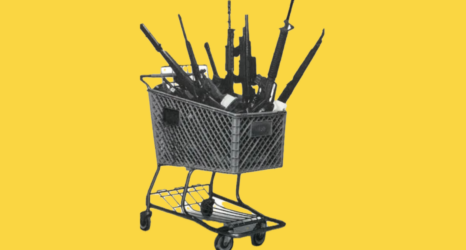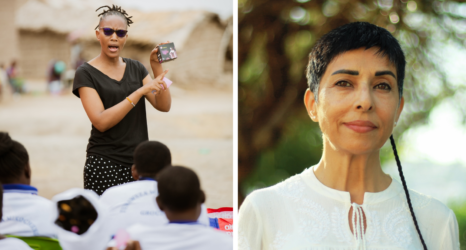Even before the Taliban ruled in Afghanistan, women were banned from riding bicycles. Though they’re no longer officially banned, women’s cycling is still frowned upon in the conservative country.
But there are groups of women winding their way through cultural taboo and beating a new path to women’s equality, and they’re being profiled in a new documentary by filmmaker Sarah Menzies: Afghan Cycles.
The Ms. Blog caught up with Menzies to talk about the motivation behind the Afghan women’s cycling movement, the still-rocky road ahead and the resilience of the women who have become the engines for social change in Afghanistan. Afghan Cycles needs support to reach completion, so if you feel moved to donate, check out the film’s Kickstarter page before Tuesday!
Why is women’s cycling so taboo in Afghanistan?
There’s nothing in the Qu’ran [or] in any laws that specifically say girls can’t ride bikes, but it’s taboo because [when] a woman has a vehicle… [it] can get her educated, it can help her get from point A to point B. It can [also] get her out of a dangerous situation. And then, of course, [there is] the taboo of putting something between your legs. Straddling a bike seat is something that we, in our own women’s suffrage movement, had to work through … [there was a belief] it could compromise virginity. That thought is changing in Afghanistan, but in the more rural areas that is [still] a hurdle that they’re up against. But in Kabul and Bamiyan, cycling is beginning to take off. More women are beginning to participate in sport throughout the progressive areas of Afghanistan, but I think cycling has been the last one to take off because it’s public. You can play volleyball or basketball in the safety of a gym, but cycling, more often than not, you’ve got be outside to really enjoy it.
You’re profiling three different cycling teams in Afghanistan: the Women’s National Cycling Team, a girls’ cycling team in Bamiyan and an informal team who cycle in the streets of Kabul. What drives these women and girls to ride?
The team that’s riding bikes on the busy streets of downtown Kabul and doing it all in their regular streets clothes, their goal is to just normalize the image of a girl on a bike. They want that to be less shocking and more normal. The Bamiyan team and the National Team both have goals of wanting to compete internationally. But competition aside, they also just want a normal life. They want to be able to pave the way so that maybe their younger sisters or their daughters someday can ride, whether it’s competitively or just to run errands more efficiently or get to school safely. Boys and men are riding bikes all the time, but the idea of a girl on a bike is still so foreign. They understand they’re up against a lot in terms of getting proper training and to be able to fund trips to get to races. They’re still quite a ways off from a having a viable cycling program, but they’re really just riding bikes because they love riding bikes. Obviously, in doing so, they’ve encouraged more women to do it, but their goal here is just to be getting on the bike because they love it.
The Afghan Cycles film crew is all women. How did this affect your ability to tell this story authentically?
I think that that’s really given us a unique connection to these girls. We’ve formed [this closeness] with the girls and they can talk to us because we’re women. That’s given us some pretty unique access into these girls’ lives. It was really important that we gained the trust of these girls because they’re talking about something so taboo. We had to find that common ground as young women and understand that we have a world between us and maybe we’re not so different.
I think [as director] my biggest insecurity is being a white western woman trying to tell this story of Afghan girls. I want this to be a really authentic story and I don’t want to be telling it necessarily from a westerner’s point of view. I want it to be told from [the point of view of] these girls that we’ve gotten to know.
What kind of opposition do women cyclists face?
The girls that are riding there, they’re subjected to violence and harassment every time they get on a bike, and that’s just their reality. [People] will throw rocks at them. A couple of years ago, [one girl who] was just getting started [cycling] took a motorcycle handle to the back. This guy saw her riding and didn’t like it, so he ran into her and she was put in the hospital. It’s a male-dominated culture and a woman on a bike has freedom and independence. That can be pretty terrifying to a man who doesn’t want their daughter or wife or other women in the culture to have that sort of freedom.
But with each of those negative stories, you’re also hearing so many positive stories that I think really speaks to the fact that Afghans are capable of social change and adapting with the times. Ten years ago, the idea of a girl wearing jeans was unheard of and now you see girls walking around in the streets with skinny jeans on. There are certainly people that are threatened by it, but I think there’s more people that like the idea of it that maybe have never thought about it.
What role do men play in facilitating this movement?
More often than not, it’s their fathers or brothers who first taught them how to ride. We’re really trying to focus on those men, too. Because it is a country where men make decisions for the women in their lives, we’ll have to profile the men [in order to] show other Afghan men that there are fathers, brothers, cousins and friends that are helping these girls to ride. That’s what will shift these other men’s minds—not just seeing these girls, but seeing other men that are supporting it, too. Which, of course, is its own form of oppression, but the fact is that they do have the support of their fathers and in one case, her husband. Now all these girls [are] saying, “Well, I wouldn’t marry a man if he didn’t let me ride a bike.” I don’t think even 10 years ago girls would say that, but they’re pretty adamant about it because of what they do.
How is the increasing presence of ISIS and the Taliban in the region affecting the cycling movement?
From the looks of it [on Facebook], there’s always new girls joining. Will that last? That’s the big unknown. They’re coming off of the most violent year in the last 10 years with an unstable government and a fragile presidential setup that’s just a year old right now… that’s opened the door to instability and a lot more attacks and a bigger presence of the Taliban [and ISIS]. Some of the other women’s sports teams have actually shut down because of threats they’ve been getting. I think these girls will continue to ride, but they’re up against a lot right now and it’s a scary shift. I follow them all on Facebook and there are their smiling faces coming back from a training ride. Even with this backdrop of violence and corruption, political strife… this is what they do every day.
What inspires you most about these women and girls?
[Afghans are] up against so much with this constant fear that’s instilled in them with these random attacks that are happening daily, but life goes on and through this violence, there’s still so much humor. Everybody seems to know how to get everybody to laugh. It’s because of this fear, it’s inspired a lot of beautiful things that have become their coping mechanism and that’s something that’s very much a part of the film. Within the last two and a half years, we’ve had to cancel countless productions because of security. The girls have had to take months off from riding because of the instability [and violence] there, but they’re just so resilient. They’re still heading out and going for a ride despite a huge explosion just a couple of blocks from where they’re riding. That doesn’t stop them.
Want to help fund Afghan Cycles? Contribute here!
Photo courtesy of Afghan Cycles





